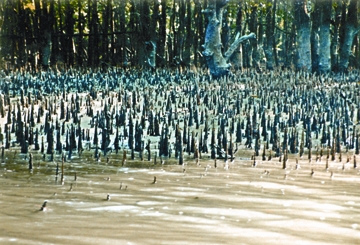Tidal Forest

Tidal Forest' forest subject to tidal action. In Bangladesh the sundarbans represents the tidal forest and constitutes the largest continuous mangrove forest in the world. The forest is located at the southern extremity of the Ganges river delta ie the plain bordering the bay of bengal to the south. This is a reserve forest and has been divided into four administrative ranges and 55 compartments. The forest is enriched with about 70 tree species, many of which are commercially important. The Sundarbans is a deltaic swamp. The land surface is flat and the elevation is hardly 3 m above mean sea level. The entire area is intersected by a complex network of streams and rivers varying considerably in width and depth. Sundri (Heritiera fomes) and Gewa (Ecoecara agallocha) are the dominant tree species. The height of the forest varies from 5 m to 20 m. As regards density, about 50% of the area have more then 70% canopy closure.
The grounds are flooded every time at tide with seawater. The evergreen plants have pneumatophores; germination is viviparous. Other than sundari, passur, gewa, keora, kankra, baen, dhundul, amur, and dakur grow gregariously. Turbidity and salinity of water regulate the constituent feature of the species.
A number of rivers namely Passur, Sipash, Arpangasia, Malaencha, and to a slight extent Jumuna and Raimangal have indirect connection, and they receive the overflow of the Ganges during rains.
They also receive a considerable amount of local drainage throughout their long and meandering courses during the monsoon. Now, only the Baleswar has direct connection and is responsible for fresh water supply to the eastern part of the forest. The soil is finely textured and the sub-soil is stratified, which at greater depth is compact. Tides in the Sundarbans are semi-diurnal with a small diurnal irregularity. Annual rainfall is in the range of 1640-2000 mm. On an average, 80% of the total annual rain is received from May to September. [Neaz Ahmad Siddiqui]
See also forest and forestry; nipa palm; sal forest; sundarbans.
